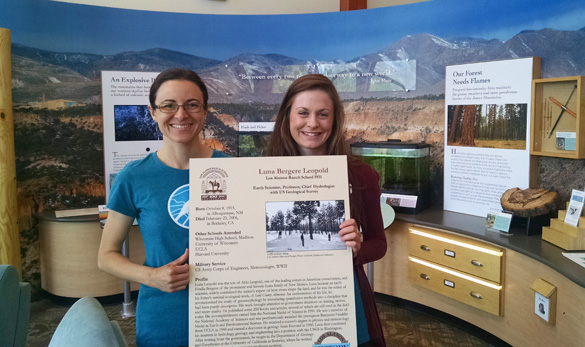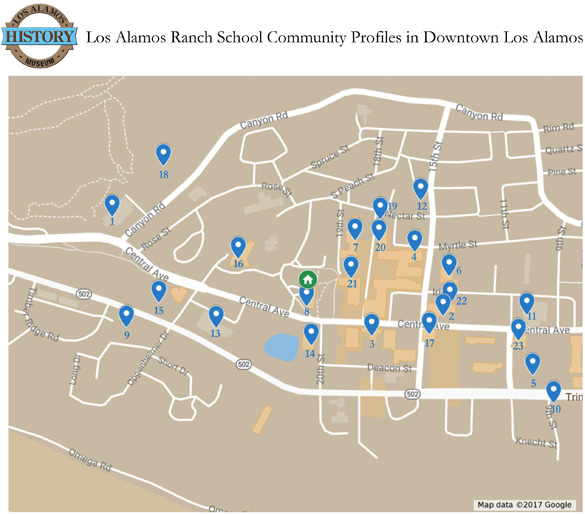 Sandra West, left, and Elizabeth Turner hold a profile of Luna Leopold, an earth scientist and hydrologist. The profile is on display at the Pajarito Environmental Education Center at the Los Alamos Nature Center. It is one of more than 30 panels about Los Alamos Ranch School students now on display around town. Photo by Aimee Slaughter
Sandra West, left, and Elizabeth Turner hold a profile of Luna Leopold, an earth scientist and hydrologist. The profile is on display at the Pajarito Environmental Education Center at the Los Alamos Nature Center. It is one of more than 30 panels about Los Alamos Ranch School students now on display around town. Photo by Aimee Slaughter
Marking the 100th anniversary of the founding of the Los Alamos Ranch School, local businesses and organizations have teamed with the Los Alamos Historical Society to share stories about some of the school’s students. From author Gore Vidal at Mesa Public Library to entrepreneur Charles Ripley at projectY, short profiles of the students and what they accomplished later in life can be seen throughout town. And information about Ranch School pets is even on display at Pet Pangaea!
“The Los Alamos Ranch School has always been important to our community, but it has a much broader importance when we consider the life achievements of the boys who came here as students and campers,” said Sharon Snyder, a leading historian on the Ranch School and Publications Director for the Los Alamos Historical Society. “Many of them made significant contributions to our nation and the world. They entered the fields of medicine, science, politics, art, business, education, and a score of others. In addition to that, more than half of our LARS boys served in World War II. In these young men, we find much to be proud of.”
Between the prestigious prep school and its summer camp, more than 550 boys were part of the school from 1917 to 1943. The Historical Society is gathering biographical information on most of them. They include the president of Sears and Roebuck who built the Sears Tower in Chicago, the president of Quaker Oats, the owner of the Chicago White Sox, a base commander for Project Y at Los Alamos during the Manhattan Project, and many more.
Now residents and visitors alike can gain a greater understanding of who the boys were and the impact the Los Alamos Ranch School had upon the nation. A map of where the panels can be viewed is available at the Los Alamos History Museum, 1050 Bathtub Row, as well as the Los Alamos Visitors Center in Central Park Square.
The panels around Los Alamos and White Rock premiered July 14 for ScienceFest, which kicked off this year’s celebration of Ranch School history, and they will continue to be displayed through the end of the year in conjunction with a new exhibit about the boys and the school’s impact at the Los Alamos History Museum.
While part of the exhibit is now on display, it will be growing over the next few weeks. A grand opening is slated for Friday, Sept. 15, and will include a Ranch School in Fuller Lodge. Several members of the boys’ families will be traveling to Los Alamos to join us for this event. The following day, the Historical Society’s annual gala will commemorate the Ranch School. Instead of the usual black-tie event, men are encouraged to dress in the attire of the school boys—shorts and a Boy Scout uniform shirt.
Keep an eye out for more information coming soon about these events. Tickets to the gala are available at https://losalamoshistory.networkforgood.com/events/2706-annual-fall-gala.
Los Alamos is world famous because of its role in the Manhattan Project, but before the scientists, engineers, technicians, and their families took over the mesa, faculty and staff at the Los Alamos Ranch School were training boys to become national leaders in business and the arts. One of the major reasons the school was chosen as the site for a top-secret WWII laboratory was the infrastructure at the school—a large dining hall (Fuller Lodge), running water and electricity, and other assets that would give the fledgling lab a start. That makes the Los Alamos Ranch School integral to the history of all of us.



